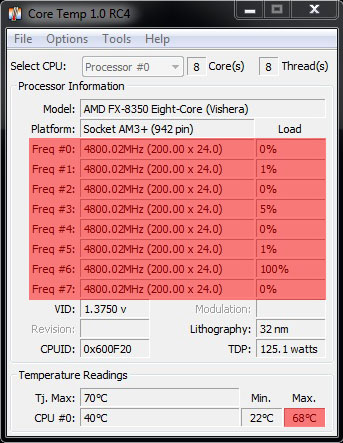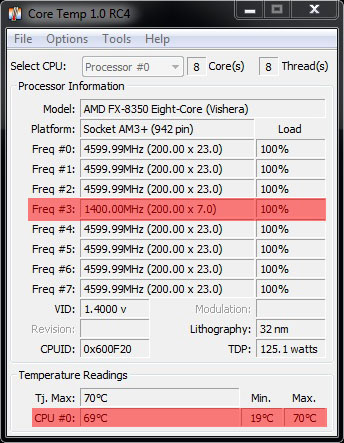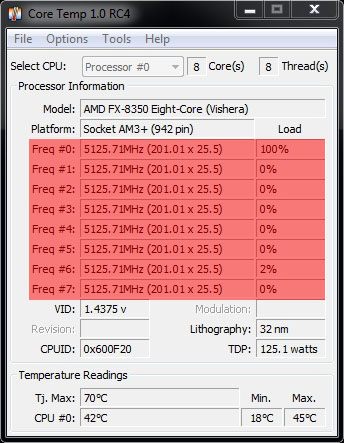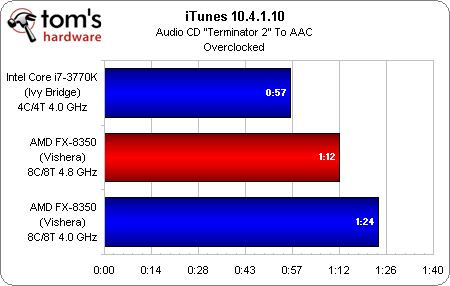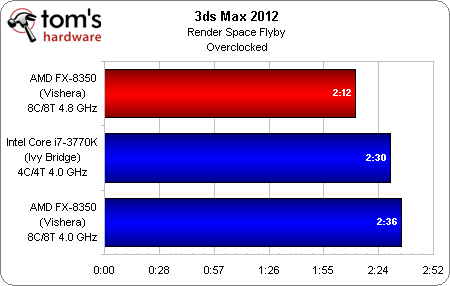AMD FX-8350 Review: Does Piledriver Fix Bulldozer's Flaws?
Last year, AMD launched its Bulldozer architecture to disappointed enthusiasts who were hoping to see the company rise to its former glory. Today, we get an FX processor based on the Piledriver update. Does it give power users something to celebrate?
Overclocking And Platform Compatibility
Overclocking
Although AMD’s CPUs haven’t been the fastest for years now, the company continues to nurture enthusiast support through products that give power users certain features important to them. Software able to manipulate configuration settings in real-time on the Windows desktop, unlocked ratio multipliers, and platforms with far more PCI Express connectivity than the competition are just a few of the nods AMD gives to the folks who know and appreciate how each of those capabilities can improve platform performance.
The same overclockers who might have been disappointed in the scalability of AMD’s Zambezi-based FX CPUs using mainstream cooling might have something to get excited about this time around, even though we’re looking at a very similar architecture manufactured on the same 32 nm node.
Using a 1.375 V CPU voltage and a 1.175 V northbridge voltage, I was able to get FX-8350 running stably at 4.8 GHz under full load. In the screen capture above, I'm running a single-threaded test to spin the chip up, but the highlighted maximum temperature is where our benchmark suite peaked.
The FX-8350 wanted to go even faster, but the key here is a voltage setting low enough that you avoid hitting 70 degrees Celsius. At that point, the thermal monitor starts cycling cores to throttle down (evidenced in the image above), keeping the chip from getting any hotter and negatively impacting performance. So long as I didn’t trigger any threaded workloads, I was even able to run benchmarks as high as 5.125 GHz (requiring a 1.4375 V CPU voltage and 1.2 V northbridge setting).
Clearly, cooling capacity is going to be a bottleneck for most folks. I find AMD’s reference heat sink and fan to be dismally insufficient, and a beefy third-party upgrade is going to add to the FX’s cost. But, for the sake of testing, I used the closed-loop liquid cooler AMD offered with its FX processors last year to reach those overclocks. Something comparable will run you $70 or so. At that point, you’d probably want to consider a Core i7-3770 for $300 as an alternative. Fortunately, I have a -3770K in our benchmark results.
Overclocking to 4.8 GHz is enough to put the FX-8350 ahead of Intel's Core i7-3770 in a threaded workload like 3ds Max 2012, but it's not going to help AMD's Piledriver architecture overcome Ivy Bridge in a single-threaded test like iTunes. Of course, if you're willing to spend an extra $30 on a Core i7-3770K and even more on an aftermarket cooler, you can take the 3.5 GHz CPU to 4.5 GHz relatively easily and flip the script on AMD's overclocked FX, too.
Get Tom's Hardware's best news and in-depth reviews, straight to your inbox.
Compatibility
All four Piledriver-based FX chips are compatible with the existing Socket AM3+ interface. Current FX-enabled motherboards need a BIOS update to recognize the new processors. However, boards that previously exhibited trouble with FX processors probably won’t get fixed. Asus’ Crosshair IV Formula, for example, should work with Bulldozer-based CPUs by AMD’s own claims.
Asus did add experimental support for the FX family back in 2011. However, the company never rolled in the update needed to stop a severe BSOD issue. As a result, many older AM3 platforms expected to properly support FX don’t, and we expect those problems to persist with Piledriver. We’ve heard assurances from AMD that the issue isn’t widespread, and that motherboard vendors are able to resolve it with an update. But certain manufacturers can’t seem to be bothered to bring older products up to date. Complaints about the Crosshair IV Formula and other motherboards are chronicled in this thread.
Current page: Overclocking And Platform Compatibility
Prev Page Meet AMD’s Piledriver-Based FX Line-Up Next Page The Piledriver Architecture: Improving On Bulldozer-
amuffin Looks like AMD did pretty well with the 8350.Reply
I now really don't see people purchasing it though....people will be buying the 8320. -
kracker Interesting, nice improvement over BD, it spars very closely or beats the i5-3570K sometimes, It really can't compete with intel's high end, but nevertheless good job AMD!Reply -
sixdegree AMD is doing good with the pricing this time. This is what AMD should be: aggressively priced CPU with added features.Reply -
esrever The price is actually nice this time. Hopefully AMD sticks around and gives good deals like this for years to come.Reply -
Nice job AMD. It just kept itself afloat! Not performance killer, but good enough to get a chunk of desktop sales just in time for the holiday season. Probably wouldn't buy it over an Intel system because most apps are still quite single threaded, but I would certainly consider it. Welcome back to the race AMD. Keep up the good work!Reply
-
najirion so... amd will still keep my local electric provider happy. Good job AMD but I think FM2 APUs are more promising. The fact that APUs alone can win against intel processors if discrete graphics is not involved. Perhaps AMD should focus in their APU line like integrating better gpus in those apus that will allow dual 7xxx graphics and not just dual 6xxx hybrid graphics. The entire FX architecture seems to have the issue with its high power consumption and poor single-thread performance. Better move on AMD...Reply -
dscudella I would have liked to see more Intel offerings in the Benchmarks. Say an i3-2120 & i3-3220 for comparisons sake as they'll be cheaper than the new Piledrivers.Reply
If more games / daily use apps start using more cores these new AMD's could really take off. -
EzioAs Interesting. Probably not a gamers first choice but for users who regularly use multi-threaded programs, the 8350 should be very compelling. About $30 cheaper than a 3570K and can be overclock as well, video/photo editors should really consider this. It doesn't beat current Intel CPUs in power efficiency but at least it's significantly more efficient than Bulldozer.Reply
Thanks for the review.
Btw Chris, how many cups of joe did you had to take for the overclocking testing? ;) -
sorry just not overly impressed.Reply
5-12% performance increase 12% less power - sound familiar?
the only difference this time was less hype before the release. (lesson well learned AMD!)
-
gorz I think the fx-4300 is going to be the new recommended budget gaming processor. Good price that is only going to get lower, and it has overclocking.Reply
